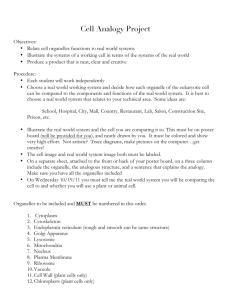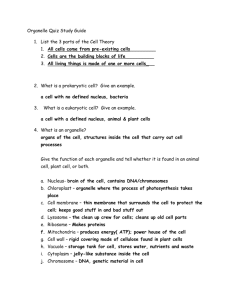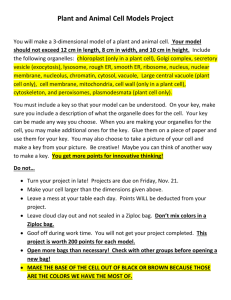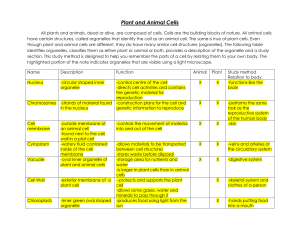Word Document
advertisement
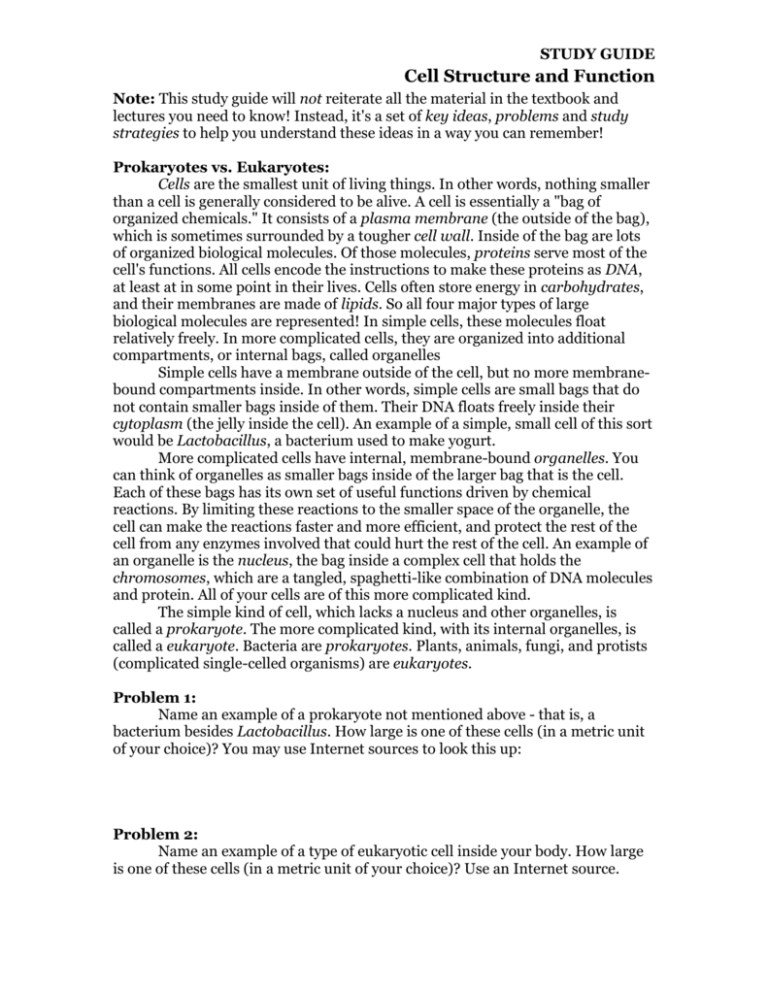
STUDY GUIDE Cell Structure and Function Note: This study guide will not reiterate all the material in the textbook and lectures you need to know! Instead, it's a set of key ideas, problems and study strategies to help you understand these ideas in a way you can remember! Prokaryotes vs. Eukaryotes: Cells are the smallest unit of living things. In other words, nothing smaller than a cell is generally considered to be alive. A cell is essentially a "bag of organized chemicals." It consists of a plasma membrane (the outside of the bag), which is sometimes surrounded by a tougher cell wall. Inside of the bag are lots of organized biological molecules. Of those molecules, proteins serve most of the cell's functions. All cells encode the instructions to make these proteins as DNA, at least at in some point in their lives. Cells often store energy in carbohydrates, and their membranes are made of lipids. So all four major types of large biological molecules are represented! In simple cells, these molecules float relatively freely. In more complicated cells, they are organized into additional compartments, or internal bags, called organelles Simple cells have a membrane outside of the cell, but no more membranebound compartments inside. In other words, simple cells are small bags that do not contain smaller bags inside of them. Their DNA floats freely inside their cytoplasm (the jelly inside the cell). An example of a simple, small cell of this sort would be Lactobacillus, a bacterium used to make yogurt. More complicated cells have internal, membrane-bound organelles. You can think of organelles as smaller bags inside of the larger bag that is the cell. Each of these bags has its own set of useful functions driven by chemical reactions. By limiting these reactions to the smaller space of the organelle, the cell can make the reactions faster and more efficient, and protect the rest of the cell from any enzymes involved that could hurt the rest of the cell. An example of an organelle is the nucleus, the bag inside a complex cell that holds the chromosomes, which are a tangled, spaghetti-like combination of DNA molecules and protein. All of your cells are of this more complicated kind. The simple kind of cell, which lacks a nucleus and other organelles, is called a prokaryote. The more complicated kind, with its internal organelles, is called a eukaryote. Bacteria are prokaryotes. Plants, animals, fungi, and protists (complicated single-celled organisms) are eukaryotes. Problem 1: Name an example of a prokaryote not mentioned above - that is, a bacterium besides Lactobacillus. How large is one of these cells (in a metric unit of your choice)? You may use Internet sources to look this up: Problem 2: Name an example of a type of eukaryotic cell inside your body. How large is one of these cells (in a metric unit of your choice)? Use an Internet source. STUDY GUIDE Cell Structure and Function Learning about Structure and Function: You should know more than the names of organelles. You must understand both the structure of these membrane-bound compartments, and also their biological function. Here are several strategies to help you learn both. Strategy 1: Draw well-labeled pictures. Problem 3: All of the membranes in the cell, including the plasma membrane, nuclear membrane, ER (endoplasmic reticulum) and organelle membranes, are made of a phospholipid bilayer. Draw the structure of the phospholipid bilayer below, clearly labeling the hydrophobic and hydrophilic parts of the molecules that make it up! Below your drawing, briefly explain why one end of each molecule is hydrophobic, and the other is hydrophilic. (Hint: Think about hydrogen bonds.) Problem 4: In the space below, draw a prokaryotic cell with the key parts labeled. You do not need to include cilia, flagella, or any of the other parts I said could be skipped in lecture! Focus on clearly labeling the membrane, cell wall, and nucleoid region (not an organelle, just a cluster of DNA). STUDY GUIDE Cell Structure and Function Problem 5: Draw a eukaryotic cell, labeling the following parts: plasma membrane, nucleus, chromosomes, mitochondrion, rough ER, smooth ER, ribosomes, lysosome, transport vesicle, vacuole, and Golgi apparatus. (Some parts may look similar to each other.) Next to your drawing, write the function of each organelle. You don't need to show the cytoskeleton, but you should know what it does! STUDY GUIDE Cell Structure and Function Strategy 2: Make Predictions about the Consequences of Breaking the Cell In science, one of the best ways to learn how something works is to break it and see what happens! Here's an analogy. Suppose you're in an old apartment with an unlabeled box of circuit breakers. You don't know which circuit each switch in this fuse box controls. One way you could figure this out would be to turn on some lights, flip the switches one at a time, and see which lights go out as the power was cut. Likewise, scientist often "break biological circuits" either by using organisms with changes to their DNA that can "break" certain proteins, or by adding drugs that can block the action of certain proteins. One way to make sure you really understand biology is to see if you can make a justified hypothesis about what would happen if you "broke" the cell in some way, and why. Problem 6: Cyanide consists of a carbon atom with a triple covalent bond to a negatively charged nitrogen atom. (If you didn't understand that, review the study guide on atoms and molecules!) It is highly poisonous; it prevents electrons from being transferred to oxygen inside of mitochondria. How would this lead to someone's death? Let's break the problem down into two parts. a) How would cyanide poisoning affect the function of mitochondria, and why? Be specific. Do not simply say "they would stop working." You may want to review how the mitochondrion makes ATP. b) How could the effect above kill someone?





